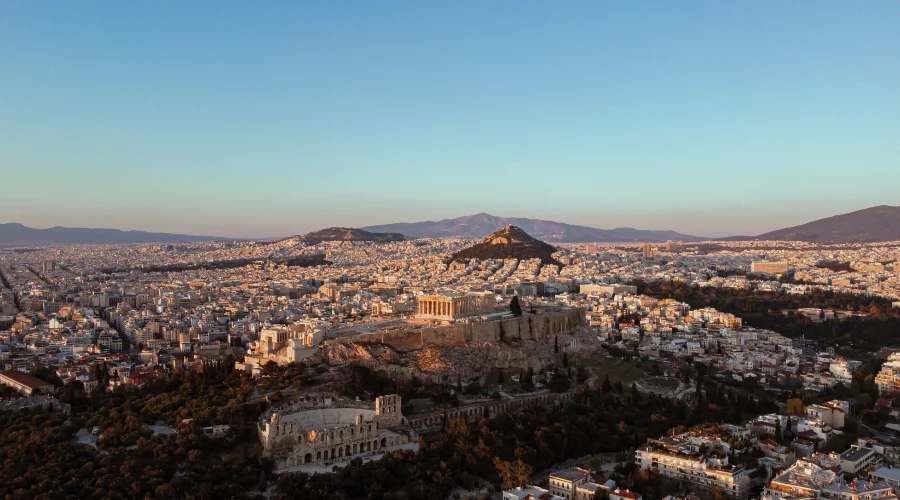
Perched atop a rocky hill in the heart of Athens, Greece, the Acropolis stands as a symbol of ancient civilization and architectural brilliance. This historical site, dating back to the 5th century BCE, represents the zenith of classical Greek art and culture. The word “Acropolis” itself means “high city,” and it served as the religious and ceremonial center of ancient Athens.
The Acropolis is home to several significant structures, most notably the Parthenon, a temple dedicated to the goddess Athena, who was considered the patroness of Athens. Other important buildings include the Erechtheion, the Temple of Athena Nike, and the Propylaea, the grand entranceway to the Acropolis. These structures were built under the leadership of Pericles during what is often referred to as the Golden Age of Athens, showcasing the architectural and artistic prowess of the ancient Greeks.
The Acropolis is renowned for its architectural innovations and artistic achievements. The Parthenon, for example, is celebrated for its perfect proportions and intricate sculptures. Designed by architects Iktinos and Kallikrates and sculpted under the direction of Phidias, the Parthenon embodies the principles of classical architecture, including harmony, symmetry, and balance. Its Doric columns and sculpted friezes depicting scenes from Greek mythology are masterpieces of ancient art.
The Erechtheion is another architectural marvel, notable for its asymmetrical design and the famous Caryatids, sculpted female figures serving as columns. This temple was built to accommodate the uneven terrain of the Acropolis and honor both Athena and Poseidon, reflecting the complex religious practices of ancient Athens.
The Temple of Athena Nike, though smaller, is significant for its graceful Ionic columns and frieze depicting the victory of the Athenians over the Persians. The Propylaea, the grand gateway to the Acropolis, impresses with its monumental scale and the skillful integration of Doric and Ionic elements.
The Acropolis was designated a UNESCO World Heritage Site in 1987, recognizing its outstanding universal value to humanity. This recognition is a testament to the Acropolis’s historical, cultural, and architectural significance. The process of becoming a UNESCO World Heritage Site involves rigorous evaluation based on criteria such as the site’s authenticity, integrity, and its contribution to world heritage.
The Acropolis meets several UNESCO criteria, including its representation of a masterpiece of human creative genius (Criterion i), its influence on subsequent cultures and civilizations (Criterion ii), and its association with ideas and beliefs of universal significance (Criterion vi). The site’s preservation and presentation of ancient Greek culture and its influence on Western civilization played a crucial role in its selection as a World Heritage Site.
Today, the Acropolis continues to be a major cultural and tourist attraction, drawing millions of visitors from around the world each year. Efforts to preserve the Acropolis of Athens are ongoing, as the site faces challenges from environmental factors, tourism, and urbanization. The Greek government, in collaboration with international organizations, has undertaken extensive restoration projects to safeguard the Acropolis for future generations.
One of the most significant preservation efforts is the Acropolis Restoration Project, initiated in the 1970s. This project involves meticulous research, documentation, and conservation work to address the damage caused by pollution, natural aging, and earlier restoration attempts. The project has employed advanced technologies and traditional craftsmanship to restore the structural integrity and aesthetic value of the monuments.
The Acropolis of Athens stands as a monumental testament to ancient Greek civilization, embodying the cultural, artistic, and architectural achievements of the classical era. Its designation as a UNESCO World Heritage Site underscores its universal value and the necessity of preserving this iconic landmark for future generations.
The ongoing restoration and preservation efforts highlight the dedication of the international community to safeguard the Acropolis against the ravages of time, pollution, and human impact. By combining advanced technologies with traditional techniques, these efforts strive to maintain the integrity and authenticity of the Acropolis while ensuring that it remains an accessible and inspirational site for visitors worldwide.
As we continue to admire and study the Acropolis, it serves not only as a link to our past but also as a reminder of the enduring power of human creativity and the importance of preserving our shared heritage.
